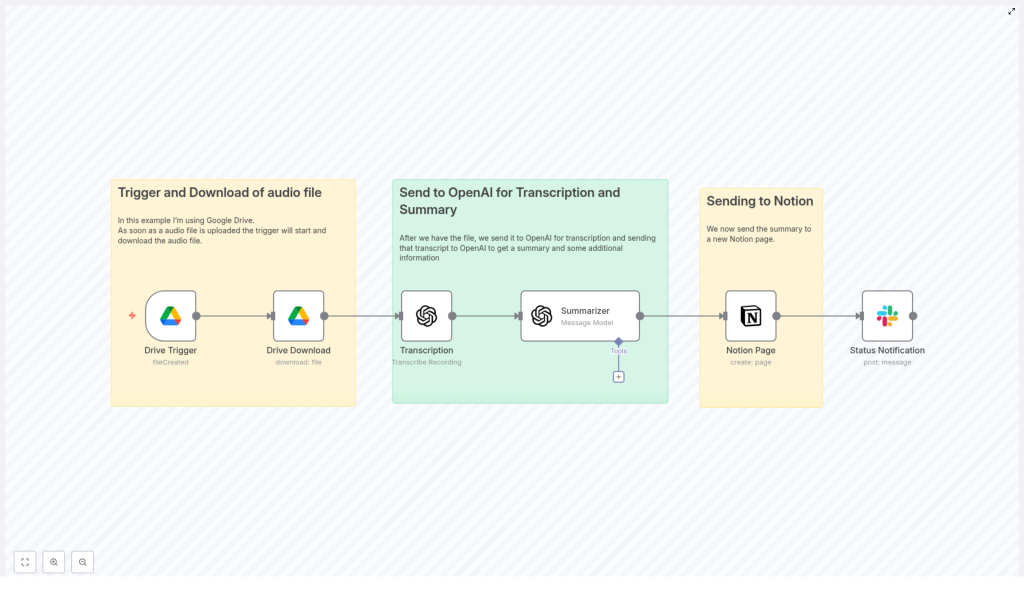Automate Transcription with n8n, OpenAI & Notion
Turn recordings into searchable notes and action items automatically. This guide walks through a complete Whisper-style transcription workflow using n8n: Google Drive trigger → download → OpenAI transcription → GPT summary → Notion page → Slack notification.
Why automate transcription?
Manual transcription is slow, error-prone, and hard to scale. An automated pipeline saves time, keeps knowledge centralized, and ensures every meeting or recording generates usable outputs like summaries, action items, and follow-ups.
Overview of the workflow
The workflow in this tutorial mirrors the provided diagram and template. The main steps are:
- Drive Trigger: watch a specific Google Drive folder for new audio files.
- Drive Download: download the uploaded file into the n8n execution.
- Transcription: send the binary audio to OpenAI’s audio/transcribe resource (Whisper or OpenAI audio API).
- Summarizer: use a GPT model (e.g., gpt-4-turbo-preview) with a structured system prompt to convert transcript into a JSON summary.
- Notion Page: create or append a Notion page with the title, summary, and structured fields.
- Status Notification: send a Slack message to notify stakeholders the transcript and summary are ready.
Step-by-step: Building the n8n workflow
1. Drive Trigger
Configure the Google Drive Trigger node to watch a specific folder. Set the event to fileCreated and use a reasonable polling frequency (every minute is typical for near-real-time). Make sure the Drive credentials have the correct permissions to read the folder.
2. Drive Download
Use the Google Drive node to download the file. Map the file ID from the trigger node and store the audio data to a binary property (for example, data). This keeps the file available for the transcription node.
3. Transcription (OpenAI audio)
Send the downloaded binary to the OpenAI audio/transcribe operation in the LangChain/OpenAI node inside n8n. Configure the node with your OpenAI API key and choose the appropriate model. For many use cases, Whisper-like models or the OpenAI audio transcription endpoint work well. Consider language detection and set language parameter if known to improve accuracy.
4. Summarizer (GPT model)
Pass the transcript text to a GPT model (the example uses gpt-4-turbo-preview). Use a carefully designed system prompt that instructs the model to produce a structured JSON summary containing:
- title
- summary
- main_points
- action_items (date-tagged if relative dates are mentioned)
- follow_up
- stories, references, arguments, related_topics
- sentiment
Tip: request a JSON-only response and include an example format in the prompt to improve consistency. If you require date tags, use ISO 8601 for absolute dates (e.g., 2025-10-24) and a clear conversion rule for relative phrases like “next Monday”.
5. Notion Page
Parse the summarizer’s JSON (if returned as a string) and map the fields to a Notion page creation node. Include the title, a short summary block, and optional database properties (tags, meeting date, participants). Use Notion credentials scoped to create pages in your workspace.
6. Status Notification
Once the Notion page is created, send a Slack message or email to notify the team. Include a direct link to the Notion page and a one-line summary to encourage quick review.
Prompt engineering and reliability tips
- Be explicit: tell the model to only output valid JSON and supply a full JSON example.
- Validate: add a small validation node in n8n (or a code step) to confirm the response is valid JSON before writing to Notion.
- Handle long transcripts: chunk long audio or transcripts and summarize each chunk before combining results to avoid model token limits.
- Noise and language: if recordings are noisy or multilingual, run a language-detection step or pre-process audio to improve accuracy.
Security and access
Keep API keys and credentials secure. Use n8n’s credential storage (never hard-code keys in workflows). Limit Drive and Notion scopes to just what the workflow needs (least privilege). Consider using a service account for Google Drive watchers if you want centralized file upload rather than individual accounts.
Monitoring, error handling, and retries
Implement basic error handling:
- Retry the transcription node on rate limit errors.
- Send an administrative Slack alert if a file fails repeatedly.
- Log transcripts and summaries to a secure S3 or Google Cloud Storage bucket as a backup before writing to Notion.
Cost and performance considerations
Transcription and GPT summarization incur API costs. To optimize:
- Transcribe only necessary audio (filter by filename or metadata).
- Use smaller models for basic summaries and reserve larger models for high-value recordings.
- Batch low-priority files and process them during off-peak times.
Advanced improvements
- Diarization: identify speakers and attach speaker labels to transcript segments.
- Action item extraction: enrich action items with assignees and due dates by cross-referencing attendees or a directory.
- Search index: push transcripts to Elasticsearch or an internal search service for enterprise search across recordings.
- Versioning: keep original transcripts and updated summaries to track edits or corrections.
Checklist before you go live
- Verify Drive trigger permissions and folder ID.
- Test with short recordings to confirm transcription and summarization output.
- Validate the JSON structure returned by the summarizer in n8n.
- Confirm Notion page creation and Slack notifications work with your credentials.
- Monitor for edge cases like very short audio, corrupt files, or unsupported formats.
Example use cases
This automated pipeline is ideal for:
- Podcast producers who want episode notes and timestamps.
- Product teams recording design reviews and extracting action items.
- Customer success teams archiving customer calls and follow-ups in Notion.
Final thoughts
Combining n8n with OpenAI and Notion creates a powerful, maintainable transcription workflow. It dramatically reduces manual effort and surfaces actionable insights from audio content. Start small, iterate on the prompt and error-handling, and scale when your pipeline proves reliable.
Call to action: Want the n8n template used for this tutorial? Download the workflow, test it in a staging folder, and subscribe for more automation templates and prompt examples. Need help customizing the pipeline for your team? Contact us for consulting or implementation support.

